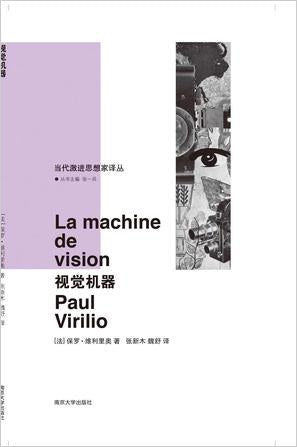1
/
of
1
Vision Machine
Vision Machine
[French] Paul Virilio Zhang Xinmu and Wei Shu 译
Regular price
$10.99 USD
Regular price
$9.99 USD
Sale price
$10.99 USD
Unit price
/
per
Low stock
Couldn't load pickup availability
About Book
About Book
Virilio, author of Speed and Politics, strives to define a new logic of images.
Indeed, alongside the different technologies, alongside the logistics of images, there is a logic and an era of communication that mark recent history.
The age of formal logic was the age of painting, sculpture, and architecture, which ended with the 18th century. The age of dialectical logic was the age of photography, the age of cinema, or, if you will, the age of the photograph.
The age of perverse logic ushered in with the invention of video communication, holography, and computer graphics. It seemed that by the end of the 20th century, the end of modernity itself was marked by the end of the logic of public representation. However, if we understand the reality of the formal logic of traditional pictorial representation and, to a lesser extent, the dialectical logic that governs optical cinematic representation, we can only with difficulty comprehend the potential of this perverse logic—the potential of video communication, holography, or the synthetic image. This is precisely the question that Paul Virilio's The Vision Machine now addresses, attempting to clarify the significance of the evolution of representational techniques. In this representation, the "public space" of the city-state suddenly gives way to the "public image," the perverse image of real-time presence that replaces the real space between subject and object.
Editor's Recommendation: "The Visual Machine," a seminal collection of essays by renowned French philosopher Paul Virilio on new technologies and the new logic of the image. It includes five essays: "Topographic Amnesia," "Less Than an Image," "The Public Image," "The Naive Camera," and "The Visual Machine." In these essays, the author traces the evolution of representational techniques, from the formal logic of painting, sculpture, and architecture to the dialectical logic of photography and film, and on to the paradoxical logic of our own era. In today's era, ushered in by video communication, holography, and computer graphics, the "public space" of the city-state has suddenly given way to the "public image," a paradoxical image of real-time presence, and this real time replaces the real space between subject and object. The author attempts to answer these questions and clarify their significance.
Indeed, alongside the different technologies, alongside the logistics of images, there is a logic and an era of communication that mark recent history.
The age of formal logic was the age of painting, sculpture, and architecture, which ended with the 18th century. The age of dialectical logic was the age of photography, the age of cinema, or, if you will, the age of the photograph.
The age of perverse logic ushered in with the invention of video communication, holography, and computer graphics. It seemed that by the end of the 20th century, the end of modernity itself was marked by the end of the logic of public representation. However, if we understand the reality of the formal logic of traditional pictorial representation and, to a lesser extent, the dialectical logic that governs optical cinematic representation, we can only with difficulty comprehend the potential of this perverse logic—the potential of video communication, holography, or the synthetic image. This is precisely the question that Paul Virilio's The Vision Machine now addresses, attempting to clarify the significance of the evolution of representational techniques. In this representation, the "public space" of the city-state suddenly gives way to the "public image," the perverse image of real-time presence that replaces the real space between subject and object.
Editor's Recommendation: "The Visual Machine," a seminal collection of essays by renowned French philosopher Paul Virilio on new technologies and the new logic of the image. It includes five essays: "Topographic Amnesia," "Less Than an Image," "The Public Image," "The Naive Camera," and "The Visual Machine." In these essays, the author traces the evolution of representational techniques, from the formal logic of painting, sculpture, and architecture to the dialectical logic of photography and film, and on to the paradoxical logic of our own era. In today's era, ushered in by video communication, holography, and computer graphics, the "public space" of the city-state has suddenly given way to the "public image," a paradoxical image of real-time presence, and this real time replaces the real space between subject and object. The author attempts to answer these questions and clarify their significance.
Publication Date
Publication Date
2014-08-01
Publisher
Publisher
南京大学出版社
Imprint
Imprint
Refraction Set
Pages
Pages
147
ISBN
ISBN
9787305129995
share

